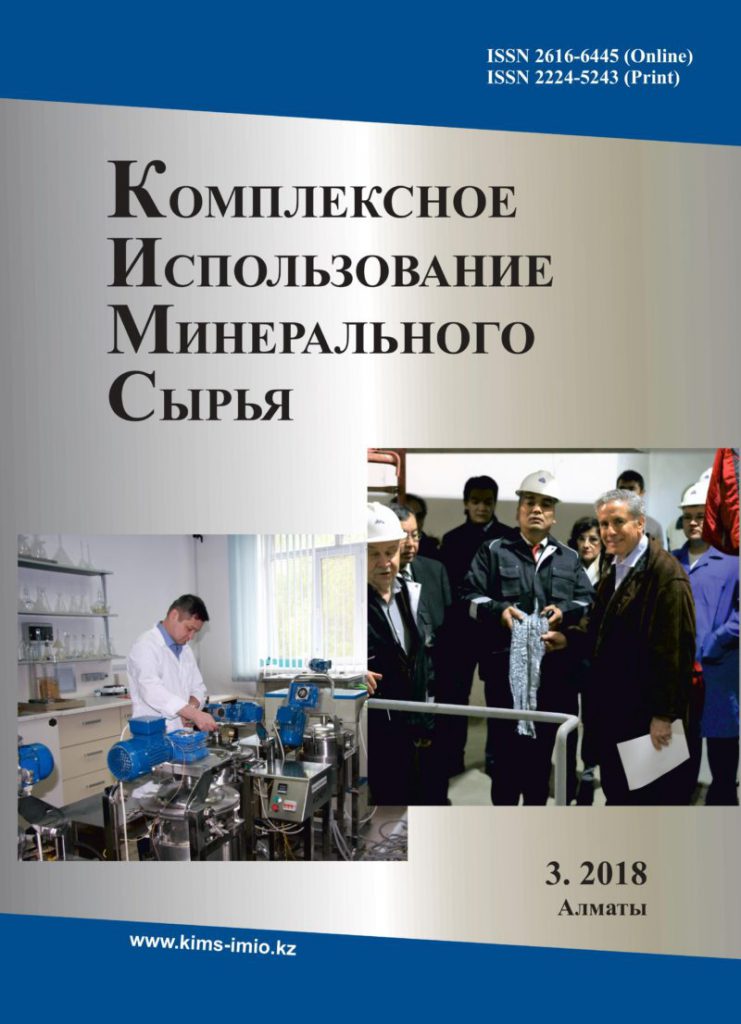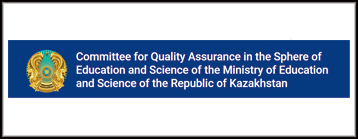The study of oxidizing roasting of vanadium-containing ore with alkali metal salts
DOI:
https://doi.org/10.31643/2018/6445.15Keywords:
vanadium-containing ore, roasting, calcined soda, sodium chloride, semi-quantitative X-ray phase and spectral analysis.Abstract
The article contains the vanadium-containing ores oxidation of the Balasauskandyk and Kurumsak deposits in Kazakhstan using pyro-metallurgical methods upon availability of alkali metal salts; and the influence of various effects (temperature, the sort and reagents consumption) on the vanadium react degree to a soluble form has been studied. This like reducing-oxidizing roasting upon availability of alkali metal salts may contribute to the vanadium react to a soluble form that will provide for a more complete recovery of vanadium in subsequent stages. Chemical testing of original vanadium-containing ores, semi-quantitative X-ray phase and spectral cinders analysis obtained after vanadium-containing ore roasting are provided. Roasting and vanadium-containing ores oxidation were carried out by different options: 1 – upon availability of calcined soda, 2 – upon availability of sodium chloride, 3 – upon availability of calcined soda and sodium chloride mixture in 700-850 ° C temperature range for 2 hours. As a result, after the complete carbon combustion in the ore SiO2 quartz content in the cinder reaches from 89 to 96% was found, also hematite Fe2O3 from 1 to 5.5%, specular stone (K,Ва)(Al,Fe,Mg,V)2(AlSi3O10)(OH)2 containing vanadium from.
Downloads
References
Borisenko L.F. Rudy vanadiya (Vanadium ore). Moscow: Nauka. 1983, 152. (in Russ).
Levintov B.L., Anosova M.O., Vavilova V.V., Bobir A.V., Namazbaev S.K. Sozdanie i perspektivy ispol’zovaniya novykh nanokristallicheskikh materialov na osnove Fe-P-Me splavov (Creation and prospects of using new nanocrystalline materials based on Fe-P-Me alloys). Kompleksnoe ispol'zovanie mineral'nogo syr'ja = Complex use of mineral resources. Almaty, 2011, 1. 62-68. (in Russ).
Vyshegorodskiy D. Ekonomicheskiy analiz: Osobennosti razvitiya Rossiyskogo proizvodstva vanadiya. Uralskiy rynok metallov (Economic analysis: Peculiarities of the development of the Russian production of vanadium. The Urals Metal Market). 2004, 11, 114-120. (in Russ).
Lebedeva M.I., Ankudimova I.A., Sviryayeva M.A. Khimiya elementov (chast 3): uchebnoye posobiye (Chemistry of Elements (Part 3): A Tutorial). Tambov: Izd-vo FGBOU VPO «TGTU». 2014, 133. (in Russ).
Kontseptsiya sozdaniya i razvitiya metallurgicheskogo kompleksa v Kyzylordinskoy oblasti (The concept of creation and development of metallurgical complex in Kyzylorda region). 2014, 20-23. (in Russ).
Nurabayev B.K., Nadyrbayev A.A., Tulegenov M.K., Tansykbayeva Zh.B. Mestorozhdeniya khroma, nikelya, kobalta, vanadiya Kazakhstana. Spravochnik. Vtoroye izdaniye (Deposits of chromium, nickel, cobalt, vanadium of Kazakhstan. Handbook. Second edition). Almaty, 2015, 237-252. (in Russ).
Kholodov V.N. Vanadiy, ego geokhimiya, mineralogiya i geneticheskiye tipy mestorozhdeniy v osadochnykh porodakh (Vanadium, its geochemistry, mineralogy and genetic types of deposits in sedimentary rocks). Moscow: Nauka. 1968, 294. (in Russ).
Ankinovich S.G. Nizhniy paleozoy vanadiyenosnogo basseyna Severnogo Tyan-Shanya i zapadnoy okrainy Tsentralnogo Kazakhstana (The Lower Paleozoic of the Vanadienous Basin of the Northern Tien Shan and the Western Margin of Central Kazakhstan). Alma-Ata. 1961, 272. (in Russ)
Ankinovich S.G., Ankinovich E.A. Uglerodisto- kremnisto-vanadiyevyj tip. V kn. Metallogeniya Kazakhstana (Carbon-silica-vanadium type. In the book. Metallogeny of Kazakhstan). Alma-Ata: Izd. AN Kaz. SSR. 1978, 101-131. (in Russ)
Ankinovich E.A., Zazubina I.S., Orlova O.S. Spetsializirovannyye issledovaniya v predelakh Balasauskandyk-Kurumsakskogo rudnogo polya (Specialized studies within the Balasauskandyk- Kurumksak ore field). Otchet KazPTI. 1986, 87. (in Russ)
Ankinovich S.G., Ankinovich E.A., Alzhanov T.M., Kalinin S.K. Metallonosnost uglerodisto- kremnistoj vanadiyenosnoj formatsii Yuzhnogo Kazakhstana (Metalliferousness of the carbonaceous- siliceous vanadic formation of Southern Kazakhstan). Sb. Metallogeniya i rudoobrazovaniye (Col. Metallogeny and ore formation). Alma-Ata: Nauka. 1979, 132-141. (in Russ).
Ankinovich E.A., Ankinovich S.G., Zazubina I.S., Diak V.N. Osobennosti raspredeleniya elementov v uglerodisto-kremnistoj vanadiyenosnoj formatsii Severo-Zapadnogo Karatau (Features of the distribution of elements in the carbonaceous-siliceous vanadienous formation of the North-Western Karatau). Sb. Voprosy metallogenii. strukturnykh osobennostey i veshchestvennogo sostava mestorozhdenij Kazakhstanа (Col. Questions of metallogeny, structural features and material composition of deposits in Kazakhstan.). Alma- Ata. 1985, 27-45. (in Russ)
Opytno-promyshlennyye ispytaniya po vyplavke vysokouglerodistogo ferrokhroma s ispolzovaniyem v kachestve flyusa vanadiysoderzhashchikh kvartsitov (Experimental-industrial tests on the smelting of high- carbon ferrochrome using vanadium-containing quartzites as a flux). Kompleksnoe ispol'zovanie mineral'nogo syr'ja = Complex use of mineral raw materials. Almaty, 1995, 3, 25-28. (in Russ).
Kunayev A.M.. Sukharnikov Yu.I. Alybayev Zh.A. i dr. Rezultaty pererabotki opytno- promyshlennoj partii vanadiyevykh kvartsitov v syryevoj shikhte Novodzhambulskogo fosfornogo zavoda (Results of the processing of the pilot industrial lot of vanadium quartzites in the feedstock of the Novodzhambul phosphor plant). Sb.: Razvitiye fosfornoy promyshlennosti v XII pyatiletke (Col.: The development of the phosphorous industry in the 12th Five-Year Plan). Chimkent. 1986. 63- 64. (in Russ).
Opytno-promyshlennyye ispytaniya po sovmestnoy pererabotke vanadiysoderzhashchikh kvartsitov i fosforitov Karatau v protsessakh proizvodstva aglomerata i zheltogo fosfora na Novodzhambulskom fosfornom zavode. Akt ispytaniye Vsesoyuznogo obyedineniye «Soyuzfosfor» (Experimental and industrial tests on the joint processing of vanadium-containing quartzites and phosphorites of Karatau in the processes of production of agglomerate and yellow phosphorus at the Novodzhambul phosphor plant. The test of the All-Union Union "Unionforsor"). 19.12.1985. (in Russ).
Tehniko-ehkonomicheskoe obosnovanie o tselesoobraznosti ispol'zovaniya vanadijsoderzhashhih kv ar cito v v proizvodstve zheltogo fosfora (vypolneno vo ispolnenie poruchenija Gosplana SSSR ot 05.01.1984 g. №29-11) (Feasibility study on the advisability of using vanadium-containing quartzites in the production of yellow phosphorus (performed in fulfillment of the order of the State Planning Committee of the USSR of 05.01.1984 No. 29-11)). LenNIIgiprohim №93045 dt. 02.01.1987. (In Russ).
Pat. 2148669 RU. Sposob pererabotki vanadiysoderzhashchego syria (Method of processing of vanadium-containing raw materials). Kozitsyn A.A., Plekhanov K.A., Mosyagin S.A., Sheveleva L.D., Lebed A.B., Khodyko I.I. Оpubl. 10.05.2000. (in Russ).
Pat. 2374345 RU. Sposob pererabotki vanadiysoderzhashchego syria (Method of processing of vanadium-containing raw materials). / Kozlov V.A., Batrakova L.Kh., Kuznetsov A.Yu., Bridzhen N.D., Saktaganov M.A. Оpubl. 27.11.2009. (in Russ).
Pat. 2437946 RU. Sposob pererabotki vanadiysoderzhashchego syrya (Method of processing of vanadium-containing raw materials). Kozlov V.A., Aymbetova I.O., Karpov A.A., Vasin E.A., Vdovin V.V. Оpubl. 27.12.2011. (in Russ).
Pat. 2266343 RU. Sposob pererabotki konvertornykh vanadiysoderzhashchikh shlakov (Method for processing of converter vanadium-containing slags). / Kozlov V.A., Kamenskikh A.A., Karpov A.A., Vdovin V.V. Оpubl. 20.12.2005. (in Russ).
Bekenova G.K. Mikro- i nanomineraly dispersnykh rud vanadiyenosnogo basseyna Bolshogo Karatau (Micro- and nanominerals of dispersed ores of the vanadienous basin of Big Karatau). Avtoref. na soisk. d.g.- m.n. 2007. 314. (in Russ).
Berozkin V.I. Uglerod: zamknutyye nanochastitsy, makrostruktury, materialy (Closed nanoparticles, macrostructures, materials). - SPb.: Izdatel'stvo «ArtEgo», 2013. 450. (in Russ).
Downloads
Published
How to Cite
Issue
Section
License
Copyright (c) 2022 Jamankulova, S., Alybaev, Z., Zhuchkov, V., & Boshkayeva, L.

This work is licensed under a Creative Commons Attribution-NonCommercial-NoDerivatives 3.0 Unported License.


























